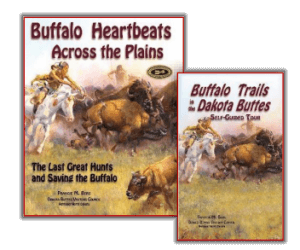By January 2019, the buffalo at Banff had been free-roaming for 5 months, after being released from their small enclosed pasture in the remote Panther Valley. They are being tracked and monitored by the Banff bison scientists with the help of GPS collar data, remote cameras and field observations.
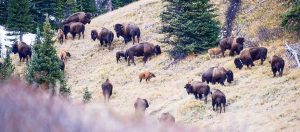
The buffalo choose to spend summer months at high elevations and the shores of alpine lakes. With the cooler days of fall they came down to lower levels where grazing was good. Courtesy of ©Parks Canada / Banff National Park
After their release, they spent their summer months at high elevations—along talus slopes and shores of alpine lakes. Then with the cooler days of fall, they came down to lower elevation meadows for excellent grazing on the grassy slopes and areas that were control-burned in the Panther and Red Deer valleys.
It takes two days for park rangers to get to these remote pastures on foot, ski or horseback, for observations on site.
“It is incredible to see these animals thriving in the wild after an absence of 140 years,” the Banff team reported. “With each passing day, they continue to prove that bison really do belong in Banff National Park.”
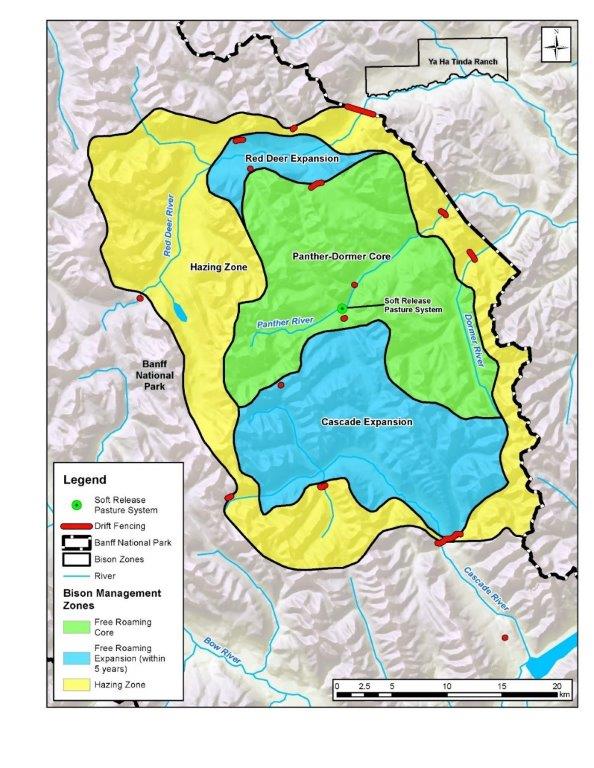
Since July 2018 the Banff herd has been free-roaming. The Red Deer and Cascade Expansions were opened (blue areas), with drift fencing (red), close monitoring and hazing if needed to encourage the buffalo to stay within the desired areas (green and blue). Image courtesy of ©Parks Canada / Banff National Park.
The 10 cows calved twice in the Soft-Release Pasture in Panther Valley—in the spring of 2017 and 2018—to help them feel at home in the mountains. This increased the herd by over 50%, bringing the total to 36, adding 20 calves to the original 16 adults brought from the plains of Elk Island National Park.
High-Tech Meets Wilderness—Parks Canada Learns from the Herd
The Banff Bison Team is highly committed to educating the public about the many aspects of the reintroducing the buffalo to remote areas of the Canadian Rocky Mountains where they lived 140 years ago.
1.They emphasize the ecological and conservation benefits that bison can bring to change the landscape and enrich plants and animals.
2.They are committed to helping indigenous people of the area renew their cultural and historical connections with the animals their ancestors once hunted here.
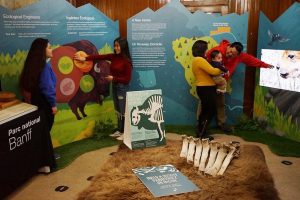
The staff is invested in helping Native people renew their cultural and historic connections with the buffalo that their ancestors once hunted here. Courtesy of ©Parks Canada / Banff National Park.
3.They are committed to increasing opportunities for Canadians and visitors to learn about the ecological and cultural importance of this iconic animal that once held such importance for Native people and early settlers in the area.
Canadians, and indeed, people throughout the world both adults and children are urged to follow the Banff buffalo herd online and to participate in related activities.
“Follow the herd from home! See what life is like for the calves by watching our new webisode on YouTube. Share it with your friends and family on social media,” they challenge.
We can all connect by following their Bison Blog, Twitter and Facebook accounts, a YouTube web series, and attending fun interpretive programs in the Banff townsite and day-use areas. Live or online.
Following are reports from 2019 and 2020 Blogs:
“The return of bison to Banff National Park is an exciting experiment in a giant natural laboratory. To observe the herd as they reintegrate into the ecosystem, our scientists use remote technology that allows us to collect information without disturbing the animals.
“Here are some of the tools we use to monitor the herd and what the research reveals.”
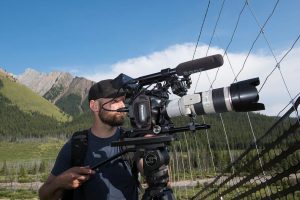
The team monitors buffalo herd with long-distance scopes and other high-tech equipment. Photo courtesy of ©Parks Canada / Banff National Park.
1–Herd tracking
“We rely on GPS radio collars as our most essential tool to monitor herd movements. Before we released the herd into the wild, we collared all the adults. The collars beam location information via satellites to a web platform that our team can access from the office.
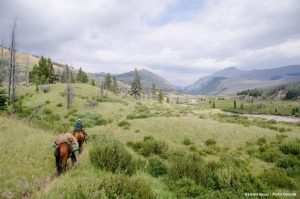
Staff riding into the remote area of Panther Valley with pack horses. It takes two days to get there via horseback—or skiing or on foot—from any direction. Courtesy of ©Parks Canada / Banff National Park.
Panther Valley is located in one of the most remote parts of the park. It takes two days to get there on foot, ski or horseback from any direction.
“The collar data tells us about how the animals adapt to their new home and the type of habitat they prefer. We closely observe which animals travel together, and for the most part, they have all been travelling as a large group with some side adventures along the way.
“The collars give us insight into how bison interact with other species. For a few months, we watched with curiosity as collared wolves came to investigate and the bison stood their ground.
“Unfortunately, we only observed a few interactions before the wolves ventured outside of the park boundaries where they were legally trapped and killed. We also recently collared 10 bighorn sheep within ‘bison country’ to gather information about how bison affect sheep movements and habitat use.
“Collars allow us to pinpoint the location of the herd when we are in the field. Our scientists use a radio telemetry receiver to pick up the unique signal of each collar. Then, they can approach the herd from a safe distance to record data on behaviour, herd health and number of animals.
VIDEO
“Unfortunately, the collars have a limited lifespan, and many of the original collars have naturally dropped off—leaving 6 operational collars. We plan to recollar at least 3 animals this winter to maintain the vital flow of data about the herd.”
2 – Remote cameras
“Banff’s bison travel through rugged country that is difficult to access, and they are sensitive to human presence. That is where another important piece of technology comes in: remote cameras.
“Our network of remote cameras captures the secret life of the herd. We set them up along trails we know the animals use. When an animal passes by, it triggers a sensor and captures a photo or video.
“Images from remote cameras reveal information that would be difficult to observe in person, such as detailed health observations. Remote cameras also capture some special moments that would otherwise go unseen, like this photo of three generations of the herd all in one frame.
“Our network of remote cameras captures the secret life of the herd. We set them up along trails we know the animals use. When an animal passes by, it triggers a sensor and captures a photo or video.
“Images from remote cameras reveal information that would be difficult to observe in person, such as detailed health observations. Remote cameras also capture some special moments that would otherwise go unseen, like a photo of three generations of the herd all in one frame.”
3- Scat sampling
“Wherever bison roam they leave behind bison dung, a stinky but important clue that tells us what they are eating.
“As part of a long-term monitoring program, our scientists collect dung samples from the field. We analyze the samples in the lab to track the types of plants the bison have been eating. The data helps us learn about the Banff bison diet and the type of habitat they need to thrive.”
4 – Bird monitoring
“If you see a bird soaring above you in some of Banff’s most remote valleys, a bison may have helped raise it! Birds and bison have a special relationship. Some birds, like the Brown Headed Cowbird, co-evolved with bison to pluck bugs from their back.
“Others, like the Olive-sided Flycatcher, use fuzzy bison wool to line their nests. Bison also increase grassland habitat that benefits meadow-loving birds.
“To assess the effects of bison on birds, we monitor bird populations both inside and nearby the bison reintroduction zone. By recording birdsong in the same places each spring, we track changes in species diversity and distribution.
“This non-invasive method gives us a greater understanding of the cascading impacts of returning a keystone species to the ecosystem.
“Our research in the backcountry of Banff National Park is on the leading edge of conservation science. As one of only 8 wild herds in North America, what we learn from the Banff bison herd benefits the broader world of bison conservation.”
February 2019: One Lonesome Buffalo
“When the bison herd crossed the threshold between captivity and freedom in the wilderness of Banff National Park, it was a historic moment for conservation.
“It was also the start of what has since become a solitary life for one of the herd’s bulls—bull #18— in one of Banff’s remote valleys. This blog traces his journey since the herd was released.
“The herd is spending its first morning in the wild, high on a talus slope. #18 initially grazes alongside the herd but soon breaks from the group and continues northwards, leaving the rest of the herd to meander the ridges of the Snow Creek Valley in search of alpine plants.
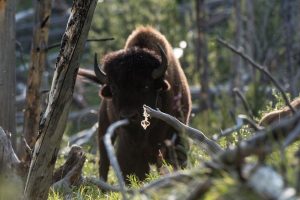
Number 18, a lonesome bull wanders alone for months. He weaves his way between willow bushes, naps at high alpine lakes and trudges through thick forest. Will he continue his solo journey thru Banff’s remote valleys? Photo courtesy of ©Parks Canada / Banff National Park.
“Edging across the slopes, #18 weaves his way between willow bushes and ambles down an old trail into the Red Deer Valley. For days, he explores meadows in the valley bottom. He picks through pockets of vegetation in an old burned forest.
“He eventually travels east, like the herd’s 2 other lone wandering bulls, but unlike them, he bumps into a stretch of fencing at the park boundary and returns westward. It would be the only interaction with a fence he has for the next 6 months.
“On his westerly trek back into the heart of the reintroduction zone, he turns north to follow Divide Creek. Along the way, he naps at an alpine lake and trudges through thick forest. He finally arrives in the Clearwater Valley in early September.
“This area is within the park but outside the reintroduction zone, so we deploy our staff to apply gentle pressure to redirect his movements. These efforts work to get the momentum started, and within a couple of days, he returns to his frequent haunt—the old burn in the Red Deer Valley.
“In late September, #18 makes a surprise reunion back with the main herd that is grazing in the Panther Valley. For a few days, they travel in lockstep, and then they part ways once more. #18 plods his way back to the Red Deer Valley, alone.
“For months now, #18 has spent the majority of his time in the Red Deer Valley. According to our GPS data, he has crossed paths more often with the resident wolf pack than with other bison.
“It’s normal for bulls to separate from the herd during the winter months. Bulls of breeding age tend to rejoin the herd for mating season in late July and August. What is interesting about #18 is his contrast with other bulls.
“Upon arrival to Banff, he was the oldest bull, but according to our field observations, he was one of the least dominant bulls during the soft-release phase. Following the full-release, the 2 most dominant bulls left the project area and were removed from the project, while the other bulls have generally stayed with the main herd.
“Each passing season teaches us more about Banff’s bison. Data from #18 and the rest of the animals, gathered through GPS collars, remote cameras and field observations, will help us understand how they establish home ranges and what influences their movements.
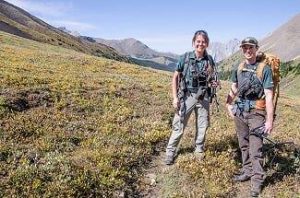
Buffalo are sensitive to human presence. The network of remote cameras captures the secret life of the herd. Remote cameras capture some special moments that would otherwise go unseen. Photo courtesy of ©Parks Canada / Banff National Park.
“We are looking forward to the spring/summer to learn more about #18’s behaviour. Will he return to the herd for mating season or will he continue his solo journey thru Banff’s remote valleys? Stay turned for updates on their movements in the coming months.
[Later:] “On a recent trip into the backcountry, our staff observed the main herd grazing in the Red Deer Valley. Everything looked normal…until we noticed the adult bull was different.
“It was no longer Bull #4 (who had been with the main herd for over a year) but Bull #18—the lonesome buffalo we wrote about back in February 2018! After a year of self-exile, Bull #18 is making some new friends.”
November 2, 2019 – Walking with Bison
“Indigenous peoples have a historical and cultural relationship with bison that spans thousands of years. The reintroduction of bison to Banff National Park fosters reconnection of this important relationship, inspires discovery, and provides stewardship and learning opportunities.
“In summer 2019, Parks Canada led a group of youth filmmakers from Treaty 7 though the remote Red Deer Valley where bison roam once again. In partnership with the Banff Centre, these filmmakers from the Nakoda A/V Club and the Napi Collective created short films inspired by their experience.
“This guest blog, written by Amber Twoyoungmen of the Nakoda A/V Club talks about the ‘making of’ and the significance of the return of bison to Treaty 7 Territory:”
“The Nakoda A/V Club is a group of young emerging Indigenous artists from the Bow Valley making films and animations about narratives that matter to us. We work together to help each other to get through tough times and to create opportunities for each other to express our stories.
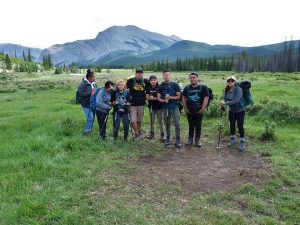
The Parks Canada team led a group of youth filmmakers—emerging Indigenous artists from the Bow Valley—through the remote Red Deer Valley where bison roam once again. “We made a movie to help tell the story.” Photo courtesy of ©Parks Canada / Banff National Park.
“In the fall of 2018 we learned about the Bison being reintroduced in Banff National Park. We saw the films that Parks Canada made about the project, and we thought about what we could add to the story.
“Bison matter to Nakoda because they were always part of this place. They belong here. Their presence is part of the Bow Valley, just as the presence of people is. At one time, Banff was understood by my people as a place of gathering, of trade, and of healing.
“We asked Parks Canada if we could help tell the story of the return of bison, and we were so happy they agreed! We invited out our neighbors, the Napi Collective from the Siksika Nation to tell stories too, because they belong here also.
“We gathered at Banff Centre to think about the stories we wanted to tell, and to learn about Bison. Some of our members got to go to the Red Deer Valley where the Bison live! When they came back, they told us about what is was like, and they’ll tell you too.”
Javan Twoyoungmen: “Being invited out to the backcountry of the Rocky Mountains was an incredible experience….The Rockies hold a precious history with the Nakoda people, walking the path my ancestors once took was a memorable experience one that I will never forget.”
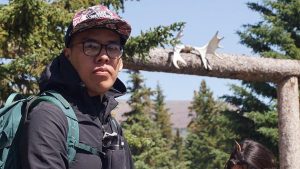
Javan Two Youngman walked the path his ancestors took in the Banff backcountry. An experience “I will never forget.” Photo courtesy of ©Parks Canada / Banff National Park.
Iris Clarke: “I can honestly say it was the hardest thing I’ve ever done in my life. I didn’t think I could hike that far. But it was the most rewarding too.”
Tashina Ear: “My experience hiking with the Parks Canada crew was very exciting but most of all, a great opportunity to learn with Parks Canada. Those very paths were also the same trails our Nakoda ancestors had walked through and I’ve never realized how hard they worked, and how long their days must have been. Our ancestors were so strong, and I want to be like them. I’ve been on simple little two-hour hikes but nothing compared to this! I’m greatly appreciative that I was given this opportunity to hike with Nakoda A/V Club members and the staff from Parks Canada.”
“After the hike, we made a movie. We used everything we learned, and everything we thought about to help tell the story we wanted to tell. As part of making that movie, we camped together, we hiked, we swam, and we went back to Banff to edit our work with the support of Banff Centre. Then we will be able to present what we made and what we learned as part of the Banff Mountain Film Festival.
“The project was such a great opportunity. Bison matter not just to us but also to lots of beings in the mountains. Parks Canada taught us about how Bison leave fur for nests, make indents for pools of water to grow, and help to create conditions for grasses to thrive.
“At one time, I might have learned this by watching the Bison here in the Bow Valley, and I’m sad that’s not the case anymore, but I’m so excited that some of our members did get to learn this way by hiking in the Red Deer Valley!
“That’s a connection to who we used to be, and who we might be again someday. In the future, our story will include all the new people in the Valley too, just as this part of our story is so intertwined with Parks Canada.
“It’s an honor to work on something important. We loved working with Parks Canada to tell the story of the return of bison to Banff. Like all our stories, it’s not meant to have an end, it’s meant to be re-told, and shared often, because in the sharing of stories we bring our gifts to the valley, just like the Bison leaves its fur for all the small birds.”
“Thank you to guest blog writer, Amber Twoyoungmen and to all of the participating filmmakers for sharing their stories with us.”
February 14, 2020: Banff’s First Wild Bison Death in 140+ Years
“We knew it was going to happen eventually: one of Banff’s bison has gone missing and, given its young age, we expect it died of natural causes.
“Back in late September, one of our staff noticed one of two bison calves born in the wild this past June was no longer with its mother and the rest of the main herd. Meanwhile, a smaller, much fuzzier and reddish calf was sticking close to another cow. Back in the office, a report was filed: one calf lost, another calf just born.
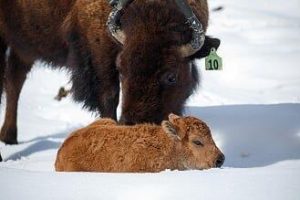
What became of the missing calf? Though sad, this first bison death is an indication of success. From this perspective, the calf still lives.” Photo courtesy of ©Parks Canada / Banff National Park.
“More than a month passed before staff could train binoculars on the increasingly elusive herd and corroborate the observation. A few weeks later, images from one of our remote cameras confirmed the situation.
“What became of the missing calf? As scientists and conservation staff overseeing the reintroduction project, we’d love to know exactly what happened, but the vastness of the 1200 km2 reintroduction zone, coupled with the increasing wildness of the herd (the missing calf’s mother is not radio collared) means we probably never will.
“This is simply an example of nature taking its course within a healthy ecosystem. The calf may have died from a predation event, succumbed to an injury or simply died in this harsh mountain environment through exposure to many natural hazards including severe weather, steep terrain and challenging stream crossings.
“What we do know is that nature wastes nothing and this first natural bison death in over 140 years will be a gain for the ecosystem of Banff National Park.
“Dozens of scavengers, including pine martens, ravens, voles, coyotes, beetles—and maybe even a wolverine or bear—will have already converted a new but ancient kind of meat, sinew and bone into their own muscles and perhaps even growing fetuses.
“And next spring the grass will be a little lusher where the bison died and the birds will be a little more active, swooping down for the insects that will still be cleaning up the site, and salvaging the remaining tufts of bison hair which the birds will use to line their nests.
“Although sad, this first bison death is an indication of success for the reintroduction project; Parks Canada’s goal, from the beginning, has been to restore the missing roles and relationships of bison within the ecosystem, not just bring back a missing animal.
“Looking at it from this perspective, the calf still lives.”
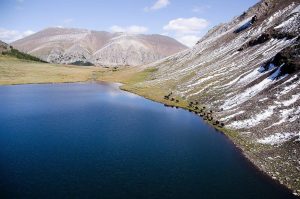
Buffalo follow single file along the edge of the lake, high in the mountains above the tree line. Photo courtesy of ©Parks Canada / Banff National Park.
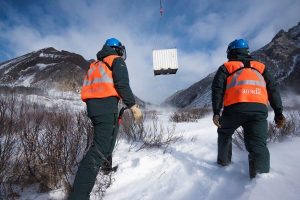
Airlifting supplies deep into the remote country of Banff National Park. Staff prepares for drop from the helicopter high overhead, May 20, 2020. Photo courtesy of ©Parks Canada / Banff National Park.
Links to Parks Canada information on the 5-year project that is returning Wild Buffalo to Banff National Park are as follows:
https://www.pc.gc.ca/en/pn-np/ab/banff/info/gestion-management/bison
https://www.pc.gc.ca/en/pn-np/ab/banff/info/gestion-management/bison/faq
https://www.pc.gc.ca/en/pn-np/ab/banff/info/gestion-management/bison/blog
Follow the landmark journey of returning North America’s largest land mammal to Canada’s first national park with the links below:
http://www.parkscanada.gc.ca/banff-bison
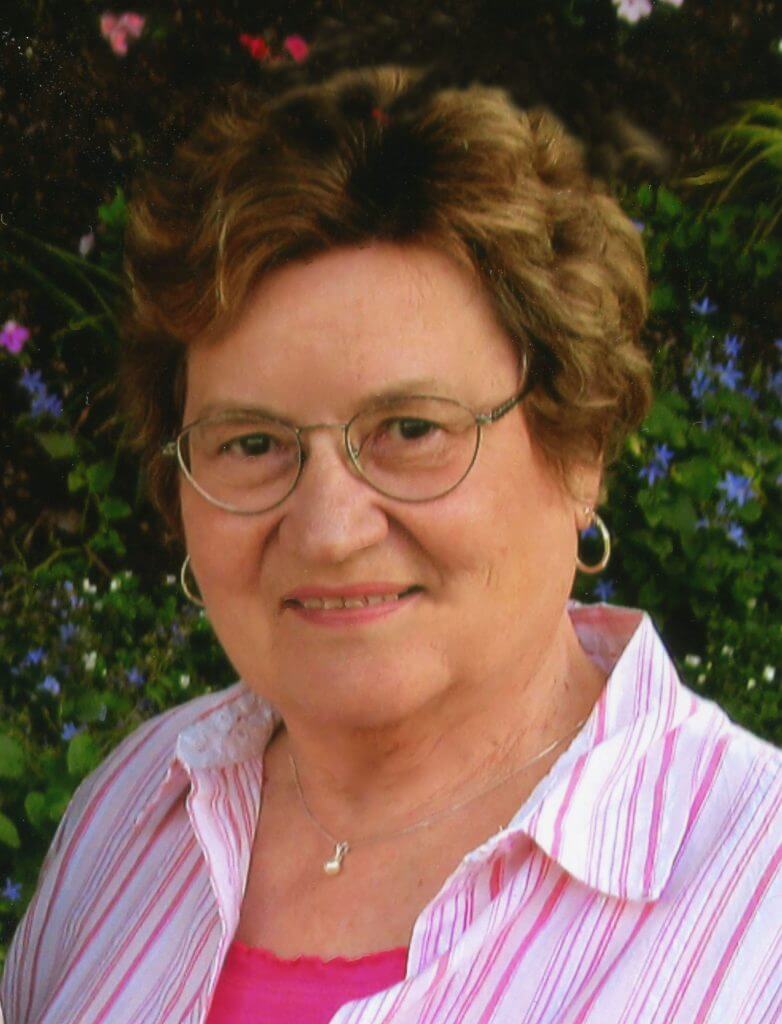
Francie M Berg
Author of the Buffalo Tales &Trails blog



